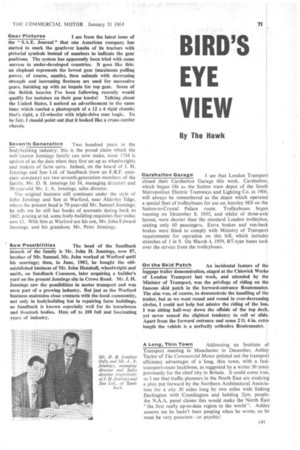BIRD'S EYE VIEW
Page 73

If you've noticed an error in this article please click here to report it so we can fix it.
By The Hawk
Gear Pictures I see from the latest issue of the S.A.E. Journal" that one American company has started to mark the gearlever knobs of its tractors with pictorial symbols instead of numbers to indicate the gear positions. The system has apparently been tried with some success in under-developed countries. It goes like this: an elephant represents the lowest gear (maximum pulling power, of course, auntie), then animals with decreasing strength and increasing fleetness are used for successive gears, finishing up with an impala for top gear. Some of the British heavies I've been following recently would qualify for tortoises on their gear knobs: Talking about the United States, I noticed an advertisement in the same issue which carried a photograph of a 12 x 6 rigid chassis; that's right, a 12-wheeler with triple-drive rear bogie. To be fair, I should point out that it looked like a crane-carrier chassis.
Seventh Generaticn Two hundred years in the
bodybuilding industry: this is the proud claim which the well-known Jennings family can now make, since 1764 is spoken of as the date when they first set up as wheelwrights and makers of farm carts. Indeed, on the board of J. H. Jennings and Son Ltd. of Sandbach (now an E.R.F, associate company) are two seventh-generation members of the family, Mr. D. B. Jennings (at 34, managing director) and 30-year-old Mr. J. A. Jennings, sales director.
Thc original business still continues under the style of John Jennings and Son at Warford, near Alderley Edge, where the present head is 79-year-old Mr. Samuel Jennings: he tells me he still has books of accounts dating back to 1807. pricing at 6d. some body-building requisites that today cost LI. With him at Warlord are his son, Mr. John Edward Jennings. and his grandson, Mr. Peter Jennings.
Saw Possibilities The head of the Sandbach branch of the family is Mr. John H. Jennings, now 87, brother of Mr. Samuel. Mr. John worked at Warford until his marriage; then, in June, 1903, he bought the oldestablished business of Mr. John Henshall, wheelwright and smith, on Sandbach Common, later acquiring a builder's yard on the present Jennings site in Crewe Road. Mr. J. H. Jennings saw the possibilities in motor transport and was soon part of a growing industry. But just as the Warford business maintains close contacts with the local community, not only in bodybuilding but in repairing farm buildings, so Sandbach is known especially well for its horseboxes and livestock bodies. Hats off to 200 full and fascinating years of industry. Oarshalton Garage I see that London Transport closed their Carshalton Garage this week. Carshalton, which began life as the Sutton tram depot of the South Metropolitan Electric Tramways and Lighting Co. in 1906. wilt always be remembered as the depot which operated a special fleet of trolleybuses for use on Anerley Hill on the Sutton-to-Crystal Palace route. Trolleyb uses began running on December 8, 1935, and whilst of three-axle layout, were shorter than the standard London trolleybus, seating only 60 passengers. Extra brakes and run-back brakes were fitted to comply with Ministry of Transport requirements for operation on this hill, which includes stretches of ( in 9. On March 4, 1959, RT-type buses took over the service from the trolleybuses.
On the Skid Patch An incidental feature of the
luggage trailer demonstration, staged at the Chiswick Works of London Transport last week, and attended by the Minister of Transport, was the privilege of riding on the famous skid patch in the forward-entrance Routemaster. The aim was, of course, to demonstrate the handling of the trailer, but as we went round and round hi ever-decreasing circles, I could not help but admire the riding of the bus. I was sitting half-way down the offside of the top deck, yet never sensed the slightest tendency to roll or slide. Apart front the forward• entrance and some 2 ft. 6 in. extra length the vehicle is a perfectly orthodox Routemaster.
A Long, Thin Town Addressing an Institute of Transport meeting in Manchester in December, Ashley Taylor of The Commercial Motor pointed out the transport efficiency advantages of a long, thin town, with a fasttransport-route backbone, as suggested by a writer 30 years previously for the chief city in Britain. It could come true, as 1 see that traffic planners in the North East are studying a plan put forward by the Northern Architectural Association for a city 30 miles long by two miles wide linking Darlington with Cramlington and holding 24m. people. An N.A.A. panel claims this would make the North East "the first really up-to-date region in the world ". Ashley assures me he hadn't been peeping when-he wrote, so he must be very prescient—or psychic!




















































































































